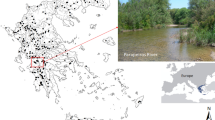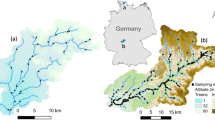Abstract
Peninsular environments are ecosystems that are one of the most vulnerable to global warming. Despite the importance of conserving regional biodiversity, peninsular environments are among the least studied with respect to the influences of global warming. In this study, we used data on benthic macroinvertebrate communities from 521 sites across Korea (a nationwide scale) to evaluate the potential impact of temperature increases on river ecosystems. Weighted averaging regression models (WARMs) were used to project the relationships between relative macroinvertebrate abundance and water temperature, based on the temperature data of the Intergovernmental Panel on Climate Change (IPCC) A1B scenario. Maximum tolerance water temperatures were used to quantify the risks to macroinvertebrates at the catchment and national scales. Ambient air temperatures in the 2090s were projected to increase by an average of 3.4 ºC relative to the baseline of the 2000s at the national scale. Mayflies, stoneflies and caddisflies were identified as potentially the most sensitive taxa to global warming. The impact of global warming on macroinvertebrates was predicted to be minimal prior to the 2060s; however, by the 2080s, species loss was predicted to be 55 %. Potential distribution ranges of cold water species in the future decades were expected to decrease continuously over time, while those of warm species were expected to increase from the 2000s to the 2040s and then decrease until the 2080s. Our projections may be useful for understanding how climate parameters affect the biogeographical patterns of aquatic biodiversity from a thermal-preference perspective.





Similar content being viewed by others
References
Araújo MB, Cabeza M, Thuiller W, Hannah L, Williams PH (2004) Would climate change drive species out of reserves? An assessment of existing reserve-selection methods. Global Change Biol 10:1618–1626. doi:10.1111/j.1365-2486.2004.00828.x
Bae MJ, Kwon Y, Hwang SJ, Chon TS, Yang HJ, Kwak IS, Park JH, Ham SA, Park YS (2011) Relationships between three major stream assemblages and their environmental factors in multiple spatial scales. Ann Limnol Int J Lim 47:S91–S105. doi:10.1051/limn/2011022
Bêche LA, Resh VH (2007) Biological traits of benthic macroinvertebrates in California Mediterranean climate streams: long term annual variability and trait diversity patterns. Fund Appl Limnol 169:1–23. doi:10.1127/1863-9135/2007/0169-0001
Bere T, Tundisi JG (2009) Weighted average regression and calibration of conductivity and pH of benthic diatom assemblages in streams influenced by urban pollution Sao Carlos/SP, Brazil. Acta Limnol Brasil 21:317–325
Birks HJB (1995) Quantitative paleoenvironmental reconstructions. In: Maddy D, Brew JS (eds) Statistical modelling of quarternary science data. Quarternary Research Association, Cambridge
Bonada N, Dolédec S, Statzner B (2007) Taxonomic and biological trait differences of stream macroinvertebrate communities between Mediterranean and temperate regions: implications for future climatic scenarios. Global Change Biol 13:1658–1671. doi:10.1111/j.1365-2486.2007.01375.x
Bradshaw WE, Holzapfel CM (2006) Evolutionary response to rapid climate change. Science 312:1477–1478. doi:10.1126/science.1127000
Burgmer T, Hillebrand H, Pfenninger M (2007) Effects of climate driven temperature changes on the diversity of freshwater macroinvertebrates. Oecologia 151:93–103. doi:10.1007/s00442-006-0542-9
Caissie D (2006) The thermal regime of rivers: a review. Freshwater Biol 51:389–1406. doi:10.1111/j.1365-2427.2006.01597.x
Castella E, Adalsteinsson H, Brittain JE et al (2001) Macrobenthic invertebrate richness and composition along a latitudinal gradient of European glacier fed streams. Freshwater Biol 46:1811–1831
Chen SQ, Chen B (2012) Defining indirect uncertainty in system-based risk management. Ecol Inform 10:10–16. doi:10.1016/j.ecoinf.2011.05.005
Chen S, Fath BD, Chen B (2011) Information based network environ analysis: a system perspective for ecological risk assessment. Ecol Indic 11:1664–1672. doi:10.1016/j.ecolind.2011.04.013
Chessman BC (2009) Climatic changes and 13 year trends in stream macroinvertebrate assemblages in New South Wales, Australia. Global Change Biol 15:2791–2802. doi:10.1111/j.1365-2486.2008.01840.x
Collier KJ, Quinn JM (2003) Land use influences macroinvertebrate community response following a pulse disturbance. Freshwater Biol 48:1462–1481. doi:10.1046/j.1365-2427.2003.01091.x
Daufresne M, Lengfellner K, Sommer U (2009) Global warming benefits the small in aquatic ecosystems. PNAS 106:12788–12793. doi:10.1073/pnas.0902080106
Davis MB, Shaw RG, Etterson JR (2005) Evolutionary responses to changing climate. Ecology 86:1704–1714. doi:10.1890/03-0788
Domisch S, Jähnig SC, Haase P (2011) Climate-change winners and losers: stream macroinvertebrates of a submontane region in Central Europe. Freshwater Biol 56:2009–2020. doi:10.1111/j.1365-2427.2011.02631.x
Dudgeon D (2007) Going with the flow: global warming and the challenge of sustaining river ecosystems in monsoonal Asia. Water Sci Technol 7:69–80
Durance I, Ormerod SJ (2007) Climate change effects on upland stream macroinvertebrates over a 25 year period. Global Change Biol 13:942–957. doi:10.1111/j.1365-2486.2007.01340.x
Fochetti R (2008) Global diversity of stoneflies (Plecoptera; Insecta) in freshwater. Hydrobiologia 595:365–377. doi:10.1007/978-1-4020-8259-7_39
Francis DR, Wolfe AP, Walker IR, Miller GH (2006) Interglacial and Holocene temperature reconstructions based on midge remains in sediments of two lakes from Baffin Island, Nunavut, Arctic Canada. Palaeogeogr Palaeocl 236:107–124
Friberg N, Milner AM, Svendsen LM, Lindegaard C, Larsen SE (2001) Macroinvertebrate stream communities along regional and physico chemical gradients in Western Greenland. Freshwater Biol 46:1753–1764. doi:10.1046/j.1365-2427.2001.00857.x
Hamilton AT, Stamp JD, Bierwagen BG (2010) Vulnerability of biological metrics and multimetric indices to effects of climate change. J N Am Benthol Soc 29:1379–1396. doi:10.1899/10-053.1
Harte J, Ostling A, Green JL, Kinzig A (2004) Climate change and extinction risk. Nature 427:145–148. doi:10.1038/nature02121
Hering D, Schmidth Kloiber A, Murphy J, Lücke S, Zamora Muñoz C, López Rodríguez MJ, Huber T, Graf W (2009) Potential impact of climate change on aquatic insects: a sensitivity analysis for European caddisflies (Trichoptera) based on distribution patterns and ecological preferences. Aquat Sci 71:3–14. doi:10.1007/s00027-009-9159-5
Hogg ID, Williams DD (1996) Response of stream invertebrates to a global warming thermal regime: an ecosystem level manipulation. Ecology 77:395–407
IPCC (2007) IPCC fourth assessment report (AR4). Cambridge University Press, Cambridge
Jablonski D, Roy K, Valentine JW (2006) Out of the tropics: evolutionary dynamics of the latitudinal diversity gradient. Science 314:102–106. doi:10.1126/science.1130880
Jenkins M (2003) Prospects for biodiversity. Science 302:1175–1177. doi:10.1126/science.1088666
Juggins S (2007) User Guide C2: software for ecological and palaeoecological data analysis and visualization. University of Newcastle, UK
Kim KH, Kim BJ, Oh JH, Kwon WT, Baek HJ (2000) Detection of urbanization effect in the air temperature change of Korea. Asia Pac J Atmos Sci 36:519–526
Kwon YA, Kwon WT, Boo KO (2008) Future projections on the spatial distribution of onset date and duration of natural seasons using SRES A1B data in South Korea. Korean Geogr Soc 43:36–51
Lytle DA, Poff NL (2004) Adaptation to natural flow regimes. Trends Ecol Evol 19:94–100. doi:10.1016/j.tree.2003.10.002
Meteorological Research Institute (METRI) (2004) The Development of Regional Climate Change Scenario for the National Climate Change Report (III). Meteorological Research Institute, Korea Meteorological Administration, Seoul
Morrill JC, Bales RC, Conklin MH (2005) Estimating stream temperature from air temperature: implications for future water quality. J Environ Eng 131:139–146. doi:10.1061/(ASCE)0733-9372(2005)131:1(139)
National Institute of Environmental Research (NIER) (2008) The Survey and Evaluation of Aquatic Ecosystem Health in Korea. NIER, Incheon, Korea. Available from http://water.nier.go.kr/index.jsp
Nevalainen L, Luoto TP (2010) Temperature sensitivity of gamogenesis in littoral cladocerans and its ecological implications. J Limnol 69:120–125. doi:10.4081/jlimnol.2010.120
Nichols SJ, Robinson WA, Norris RH (2010) Using the reference condition maintains the integrity of a bioassessment program in a changing climate. J N Am Benthol Soc 29:1459–1471. doi:10.1899/09-165.1
Park YS, Song MY, Park YC, Oh KH, Cho E, Chon TS (2007) Community patterns of benthic macroinvertebrates collected on the national scale in Korea. Ecol Model 203:26–33. doi:10.1016/j.ecolmodel.2006.04.032
Parmesan C (2006) Ecological and evolutionary responses to recent climate change. Ann Rev Ecol Evol Syst 37:637–669. doi:10.1146/annurev.ecolsys.37.091305.110100
Pearlstine LG, Pearlstine EV, Aumen NG (2010) A review of the ecological consequences and management implications of climate change for the Everglades. J N Am Benthol Soc 29:1510–1526. doi:10.1899/10-045.1
Poff NL, Pyne MI, Bledsoe BP, Cuhaciyan CC, Carlisle DM (2010) Developing linkages between species traits and multiscaled environmental variation to explore vulnerability of stream benthic communities to climate change. J N Am Benthol Soc 29:1441–1458. doi:10.1899/10-030.1
Ponader KC, Charles DF, Belton TJ (2007) Diatom based TP and TN inference models and indices for monitoring nutrient enrichment of New Jersey streams. Ecol Indic 7:79–93. doi:10.1016/j.ecolind.2005.10.003
Revenga C, Campbell I, Abell R, De Villiers P, Bryer M (2005) Prospects for monitoring freshwater ecosystems towards the 2010 targets. Philos T R Soc B: Biol Sci 360:397–413. doi:10.1098/rstb.2004.1595
Stamp JD, Hamilton AT, Zheng L, Bierwagen BG (2010) Use of thermal preference metrics to examine state biomonitoring data for climate change effects. J N Am Benthol Soc 29:1410–1423. doi:10.1899/10-003.1
StatSoft, Inc. (2010) STATISTICA, data analysis software system (version 8.0). http://www.statsoft.com
ter Braak CJF, Juggins S (1993) Weighted averaging partial least squares regression (WA PLS); an improved method for reconstructing environmental variables from species assemblages. Hydrobiologia 269–270:485–502. doi:10.1007/BF00028046
ter Braak CJF, Looman CWN (1986) Weighted averaging, logistic regression and the Gaussian response model. Vegetatio 65:3–11
Thomas CD, Cameron A, Green RE et al (2004) Extinction risk from climate change. Nature 427:145–148. doi:10.1038/nature02121
Tierno de Figueroa JM, López Rodríguez MJ, Lorenz A, Graf W, Schmidt Kloiber A, Hering D (2010) Vulnerable taxa of European Plecoptera (Insecta) in the context of climate change. Biodivers Conserv 19:1269–1277. doi:10.1007/s10531-009-9753-9
Ward JV (1992) Aquatic insect ecology, part I, biology and habitat. John Wiley and Sons, New York
Xenopoulos MA, Lodge DM, Alcamo J, Marker MD, Schuulze K, Van Vuuren DP (2005) Scenarios of freshwater fish extinctions from climate change and water withdrawal. Global Change Biol 11:1–8. doi:10.1111/j.1365-2486.2005.001008.x
Acknowledgments
This work was supported by the National Research Foundation of Korea (NRF) grant funded by the Korean government (MEST) (No. 2010-0027360).
Author information
Authors and Affiliations
Corresponding author
Rights and permissions
About this article
Cite this article
Li, F., Chung, N., Bae, MJ. et al. Temperature change and macroinvertebrate biodiversity: assessments of organism vulnerability and potential distributions. Climatic Change 119, 421–434 (2013). https://doi.org/10.1007/s10584-013-0720-9
Received:
Accepted:
Published:
Issue Date:
DOI: https://doi.org/10.1007/s10584-013-0720-9




